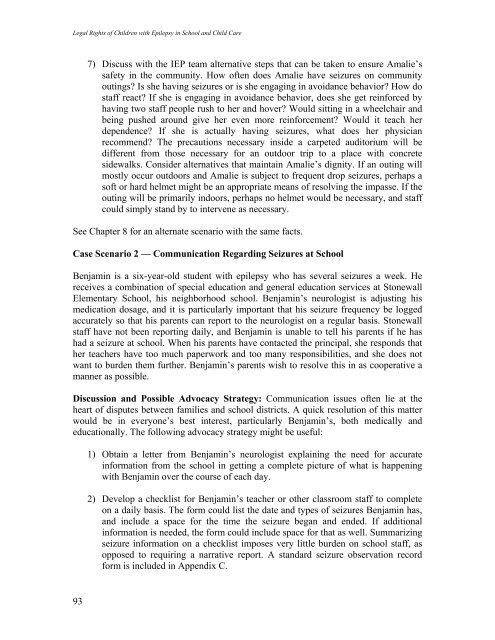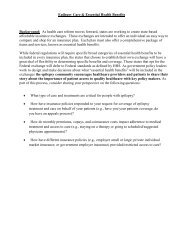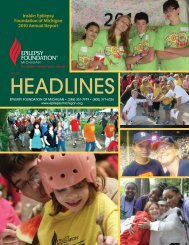Legal Rights of Children with Epilepsy in School & Child Care
Legal Rights of Children with Epilepsy in School & Child Care
Legal Rights of Children with Epilepsy in School & Child Care
Create successful ePaper yourself
Turn your PDF publications into a flip-book with our unique Google optimized e-Paper software.
<strong>Legal</strong> <strong>Rights</strong> <strong>of</strong> <strong><strong>Child</strong>ren</strong> <strong>with</strong> <strong>Epilepsy</strong> <strong>in</strong> <strong>School</strong> and <strong>Child</strong> <strong>Care</strong><br />
7) Discuss <strong>with</strong> the IEP team alternative steps that can be taken to ensure Amalie’s<br />
safety <strong>in</strong> the community. How <strong>of</strong>ten does Amalie have seizures on community<br />
out<strong>in</strong>gs? Is she hav<strong>in</strong>g seizures or is she engag<strong>in</strong>g <strong>in</strong> avoidance behavior? How do<br />
staff react? If she is engag<strong>in</strong>g <strong>in</strong> avoidance behavior, does she get re<strong>in</strong>forced by<br />
hav<strong>in</strong>g two staff people rush to her and hover? Would sitt<strong>in</strong>g <strong>in</strong> a wheelchair and<br />
be<strong>in</strong>g pushed around give her even more re<strong>in</strong>forcement? Would it teach her<br />
dependence? If she is actually hav<strong>in</strong>g seizures, what does her physician<br />
recommend? The precautions necessary <strong>in</strong>side a carpeted auditorium will be<br />
different from those necessary for an outdoor trip to a place <strong>with</strong> concrete<br />
sidewalks. Consider alternatives that ma<strong>in</strong>ta<strong>in</strong> Amalie’s dignity. If an out<strong>in</strong>g will<br />
mostly occur outdoors and Amalie is subject to frequent drop seizures, perhaps a<br />
s<strong>of</strong>t or hard helmet might be an appropriate means <strong>of</strong> resolv<strong>in</strong>g the impasse. If the<br />
out<strong>in</strong>g will be primarily <strong>in</strong>doors, perhaps no helmet would be necessary, and staff<br />
could simply stand by to <strong>in</strong>tervene as necessary.<br />
See Chapter 8 for an alternate scenario <strong>with</strong> the same facts.<br />
Case Scenario 2 — Communication Regard<strong>in</strong>g Seizures at <strong>School</strong><br />
Benjam<strong>in</strong> is a six-year-old student <strong>with</strong> epilepsy who has several seizures a week. He<br />
receives a comb<strong>in</strong>ation <strong>of</strong> special education and general education services at Stonewall<br />
Elementary <strong>School</strong>, his neighborhood school. Benjam<strong>in</strong>’s neurologist is adjust<strong>in</strong>g his<br />
medication dosage, and it is particularly important that his seizure frequency be logged<br />
accurately so that his parents can report to the neurologist on a regular basis. Stonewall<br />
staff have not been report<strong>in</strong>g daily, and Benjam<strong>in</strong> is unable to tell his parents if he has<br />
had a seizure at school. When his parents have contacted the pr<strong>in</strong>cipal, she responds that<br />
her teachers have too much paperwork and too many responsibilities, and she does not<br />
want to burden them further. Benjam<strong>in</strong>’s parents wish to resolve this <strong>in</strong> as cooperative a<br />
manner as possible.<br />
Discussion and Possible Advocacy Strategy: Communication issues <strong>of</strong>ten lie at the<br />
heart <strong>of</strong> disputes between families and school districts. A quick resolution <strong>of</strong> this matter<br />
would be <strong>in</strong> everyone’s best <strong>in</strong>terest, particularly Benjam<strong>in</strong>’s, both medically and<br />
educationally. The follow<strong>in</strong>g advocacy strategy might be useful:<br />
1) Obta<strong>in</strong> a letter from Benjam<strong>in</strong>’s neurologist expla<strong>in</strong><strong>in</strong>g the need for accurate<br />
<strong>in</strong>formation from the school <strong>in</strong> gett<strong>in</strong>g a complete picture <strong>of</strong> what is happen<strong>in</strong>g<br />
<strong>with</strong> Benjam<strong>in</strong> over the course <strong>of</strong> each day.<br />
2) Develop a checklist for Benjam<strong>in</strong>’s teacher or other classroom staff to complete<br />
on a daily basis. The form could list the date and types <strong>of</strong> seizures Benjam<strong>in</strong> has,<br />
and <strong>in</strong>clude a space for the time the seizure began and ended. If additional<br />
<strong>in</strong>formation is needed, the form could <strong>in</strong>clude space for that as well. Summariz<strong>in</strong>g<br />
seizure <strong>in</strong>formation on a checklist imposes very little burden on school staff, as<br />
opposed to requir<strong>in</strong>g a narrative report. A standard seizure observation record<br />
form is <strong>in</strong>cluded <strong>in</strong> Appendix C.<br />
93








